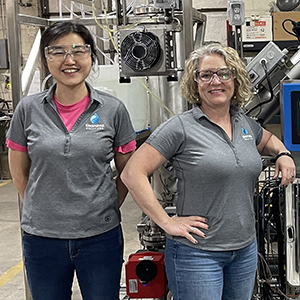Three recent NIEHS-funded studies suggest new benefits of folate supplementation in women of reproductive age. The studies indicate folate has some ability to reduce the accumulation of PFAS in blood serum, thus minimizing adverse generational effects.

Folate, or folic acid, is a B vitamin found in many foods. Recommendations vary for folate supplementation beyond dietary consumption depending on sex, age, genetics, and whether pregnant or planning to become pregnant.
Folate has long been recommended for pregnant women due to its ability to help reduce neural tube defects. Today, emerging research shows that folate may have additional protective properties important for not only pregnant women and their offspring but also for teens and others across the lifespan.
“As the senior author of these studies, my goal is to provide individuals with actionable evidence to improve their health and mitigate the risks associated with PFAS exposure,” said NIEHS grantee Carmen Messerlian, Ph.D., from Harvard T.H. Chan School of Public Health. “By framing these chemicals as 'forever chemicals,' we unintentionally create a sense of helplessness among individuals, making them believe they have no control over their body burden or the ability to reduce the associated risks. Our research challenges this narrative.”
Lessening the forever effect
One observational study conducted by Messerlian and colleagues measured PFAS and folate concentrations in blood samples of U.S. adolescents and adults and found that the higher the folate concentration, the lower the PFAS levels.
“In this large-scale, nationally representative study, we found consistent inverse associations for most examined serum PFAS compounds in relation to folate concentrations measured in either red blood cells or serum among both adolescents and adults,” the study’s interpretation section reads. “These findings are supported by mechanistic in vitro studies that show the potential of PFAS to compete with folate for several transporters implicated in PFAS toxicokinetics. If confirmed in experimental settings, these findings could have important implications for interventions to reduce the accumulated PFAS body burden and mitigate the related adverse health effects.”
Protection from adverse birth outcomes
Another study suggests that folate supplementation also reduces adverse birth outcomes commonly linked to PFAS exposure.
In a study of 1,400 pregnant women who experienced exposure to six common PFAS, only those below the 25th percentile of prenatal dietary or plasma folate levels experienced the PFAS-associated adverse birth outcomes of low birth weight or preterm birth.
To learn more about the biological interaction between folate and PFAS, read this article, which notes the following.
“Researchers hypothesized that folate might confer protection against PFAS exposure because the two compounds share common transporters in the human placenta. Specifically, the organic anion transporter family, solute carrier family, and the adenosine triphosphate–binding cassette family, implying a biological interaction between folate and PFAS.”
Folate may be good for teens, too
A third recent study suggests that folate supplementation may aid children and adolescents in proper antibody development.
PFAS — including perfluorooctane sulfonic acid (PFOS) and perfluorooctanoic acid (PFOA) — are present in blood serum and have been found to reduce circulating antibodies, which are essential for healthy immune systems. This study examined folate and PFAS red blood cell concentrations, as well as detectable rubella and measles antibody levels, in 819 adolescents aged 12-19 years.
The researchers noted that the higher the PFAS concentration, the lower the serum antibodies present to fight off a virus. Specifically, this inverse association existed among the following.
- PFOS and rubella antibodies.
- PFOA and mumps antibodies.
- PFAS mixtures and rubella and mumps antibodies.
However, these inverse associations existed only among adolescents with red blood cell folate concentrations lower than the 66th percentile and not among adolescents with higher folate levels.
The researchers also noted that a per-quartile increase in serum concentrations of total PFAS was associated with a 9.84% decrease in rubella antibody and an 8.79% decrease in the mumps antibody concentrations, but again, only in the lower folate group.
“We have discovered that folate may offer a unique opportunity for individuals to take control of their health and protect themselves and their offspring from the adverse effects of these persistent chemicals,” Messerlian said. “By focusing on the individual and emphasizing the importance of personalized dietary and lifestyle interventions, we aim to empower a sense of agency and resilience in the face of environmental challenges. Together, we can make a difference in improving health outcomes and shaping a healthier future for generations to come.”









